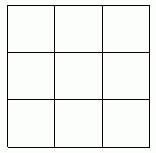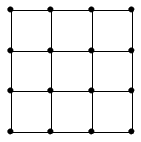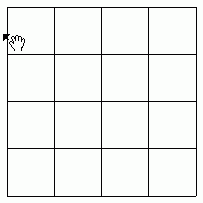
| In a mathematician's terminology, a graph is a collection of points and lines connecting some (possibly empty) subset of them. The points of a graph are most commonly known as graph vertices, but may also be called "nodes" or simply "points." Similarly, the lines connecting the vertices of a graph are most commonly known as graph edges, but may also be called "arcs" or "lines." |
| … [G]raphs in which at most one edge (i.e., one edge or no edge) may connect any two vertices are said to be simple graphs . |

- 1.
- How many graph edges (toothpicks) are there? (2 ·3 (3 + 1) = 24?)
- 2.
- On the graph, label the degree of each vertex.
- 3.
- How many vertices are there in the graph of the square with n = 4?
- 4.
- How many vertices have degree 1?
- 5.
- How many vertices have degree 2?
- 6.
- How many vertices have degree 3?
- 7.
- How many vertices have degree 4?
- 8.
- What is the sum of the the degrees of all nodes?

| Toothpick Equilateral Triangles |

- 1.
- How many graph edges (toothpicks) are there?
- 2.
- On the graph, label the degree of each vertex.
- 3.
- How many vertices are there?
- 4.
- How many vertices have degree 1?
- 5.
- How many vertices have degree 2?
- 6.
- How many vertices have degree 3?
- 7.
- How many vertices have degree 4?
- 8.
- How many vertices have degree 5?
- 9.
- How many vertices have degree 6?
- 10.
- How many vertices have degree 7?
|
|
File translated from TEX by TTH, version 3.61.
On 12 Aug 2004, 11:17.